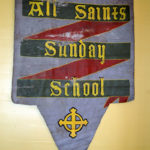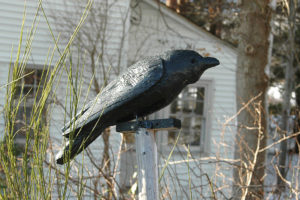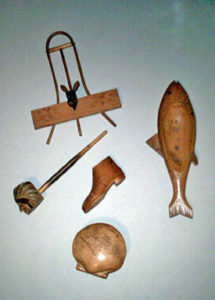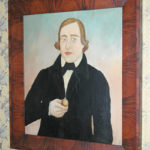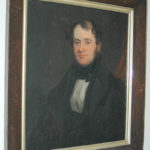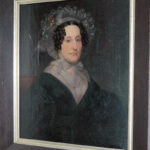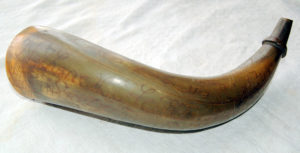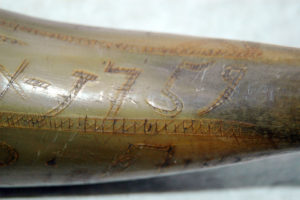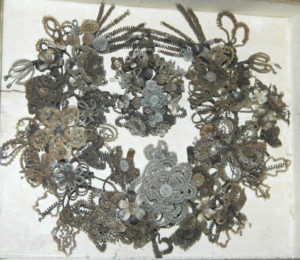Artifacts – From Our Collection
Banner from All Saints Anglican Sunday School
This is a banner from the late 19th – early 20th century that once hung in All Saints Church of England in Granville Centre, N.S.
The nearly 200-year-old church was dismantled in 2009 and relocated for use in a parish in Louisiana.
Eugene Hamm, Wood Carver
Eugene “Bud” Hamm (1919–2009) was born in Lequille NS, the son of William and Viola (Moore) Hamm. He graduated from the Agricultural College in Truro NS in 1943 and worked until 1956 in the United States. On his return to Nova Scotia he farmed in Clarence, Annapolis County.
There, his lifelong interest in wood-carving flourished, drawing on his own experience and influenced by his interest in the art of other ages and cultures. Married twice, the odd house he subsequently built in Clarence was decorated throughout with plaster relief work depicting scenes both from everyday life and from his imagination. In 1987 Eugene received a BA in English from Acadia University and later self-published a number of volumes of poetry.
The Foster Midgets
The Foster Midgets can be regarded as Nova Scotia’s contribution to the sad roll of those individuals who, because of physical anomalies, were displayed to the curious in North America and Europe throughout the 19th century. They were born in Hampton (formerly Chute’s Cove), Annapolis County, Nova Scotia, three of the eight children of Thomas H. and Elizabeth Ann (Foster) Foster. Catherine or Cassie (1865–1875) and Victoria (1871–1874) toured New England in 1872 and 1873 as the “Fairy Sisters”. Newspaper reports of the time commented on their fine clothing and tiny custom-made furniture, some of which are pictured here. Brother Dudley Foster (1877–1894), born after the deaths of his two tiny sisters, proved to be a second pot of gold for his parents, who became quite wealthy during Dudley’s lifetime. He was known professionally as “Hop-O-My-Thumb” and never weighed more than 20 pounds. A reporter at the time noted that “Hop isn’t as lively as his name would indicate. Close confinement ten hours a day on a high platform with a railing around it has made the little fellow puny and unhappy”. During a tour of England, Dudley was presented to Queen Victoria.
Louis Jeremy, Mi’kmaw Carver
Mi’maw carver Louis Jeremy was born near Brickton, Annapolis County 15 May 1867 to Josiah Jeremy and his wife, Elizabeth Paul. The family eventually settled on the opposite side of the Annapolis River near Tupperville, living in a camp several miles off the main highway at “Horseshoe Bent Meadow Brook” on the South Mountain. Like many Mi’kmaq of their generation, the family lived a semi-nomadic lifestyle, moving with the seasons to gather food and the necessities of the life to which they were accustomed. From his family Louis learned the crafts of his people, weaving specialized baskets and fashioning wood into snoeshoes or peavey stocks and ax handles for sale to neighbouring non-natives. He became noted, however, for his particular artistry with wood and the variety and delicacy of his carvings. Louis never married and lived with his unmarried elder sister, Rebecca Jeremy (1859–1949). Louis Jeremy died 17 Oct. 1947 age 80 and was buried in the Roman Catholic Cemetery in Kingston, King’s County, Nova Scotia.
Portraits
Before the advent of photography, only the relatively wealthy could afford to have their image preserved, in the form of portraits.
The more primitive pair of paintings (c. 1850) depicts John Millidge Harris (1824–1910) and his wife, Isabella Harris (1823–1907) of Upper Clements. Second cousins, he was the son of William Henry and Hannah (Hetrick). Isabella was the daughter of William Henry’s 1st cousin, James DeLancey Harris and his wife Mary Woodbury.
The second pair of portraits (c. 1840) is of George Robinson (1802–1863) and his wife, Augusta Isabella Henkell (1800–1869). He had been a Lieutenant with the 60th Regiment stationed in Annapolis Royal.
Augusta was the daughter of Dr. George Christian Henkell, German staff surgeon to the garrison in town and a friend of Prince Edward, Duke of Kent.
Powder Horn
A powder horn lightly decorated with scrimshaw of a halibut and fishing boats and inscribed: Nathaniel Horten his horn Anaplus Rial June ye 6th 1759 Eunice Horten Snow. It was undoubtedly the property of one Nathaniel Horton, b. Eastham MA 24 Feb. 1721 the son of Samuel and Hannah (Atwood) Horton. He married there 10 Apr. 1742 Eunice Snow, b. 30 Nov. 1722 d/o Jabez and Elizabeth (Paine) Snow.
His stay here was not of great duration; he died 31 Dec. 1763 and his widow remarried in Massachusetts in 1771. Her brothers, however, were settlers to Nova Scotia in the same period. Jabez Snow jr. and his wife Elizabeth Doane were planters in Granville and Joshua Snow and his wife Mary Doane settled at Barrington.
Ships Paintings
Ship paintings were emblematic of the prosperity of the Maritime Provinces during the second half of the 19th century and the “Golden Age of Sail”. Most were painted by artists in distant ports and provided a visible reminder to the ship owner of his role in the all-important shipping industry.
The John Johnson, a barque of 690 tons, was built at Annapolis Royal in 1874 by the newly formed company Pickels & Mills. The vessel was named for Granville sea captain John Johnson, father-in-law to both Christopher Pickels and Albert Mills, partners in the firm.
The Crown Jewel, a barque of 716 tons, was built at Young’s Cove, Annapolis County, in 1868 for the Troop fleet by noted shipbuilder Abraham Young. Young was the favoured shipwright of Jacob V. Troop, a native of Granville and owner of one of the largest private merchant fleets in the world, based in Saint John, New Brunswick. The Crown Jewel flies the “diamond T” house flag of the Troop fleet.
Victorian Mourning Hair Wreath
Prince Albert’s premature death in 1861 of typhoid fever sent Queen Victoria into a state of mourning that lasted until her own death in 1901. Her taste for black clothing and jet jewellery was dutifully imitated by loyal subjects throughout the Empire. The decorative hair wreath shown here was a morbid byproduct of the age. It was, as its name suggests, created entirely from the hair of departed loved ones and would have been a feature in a formal parlour.


